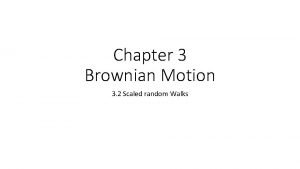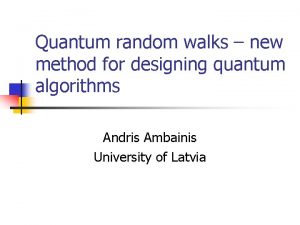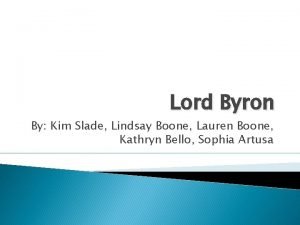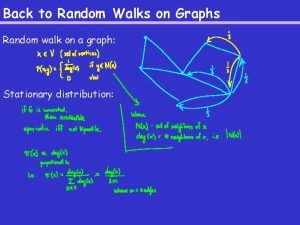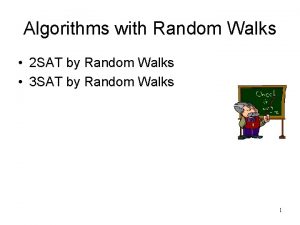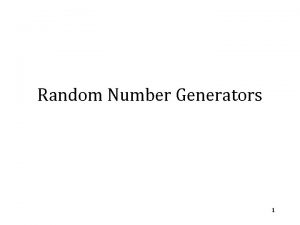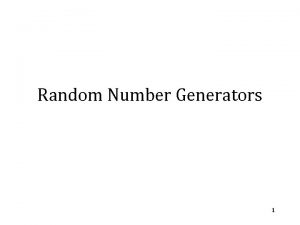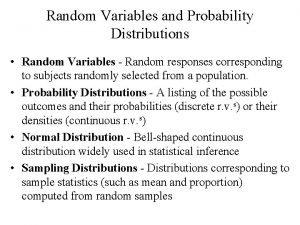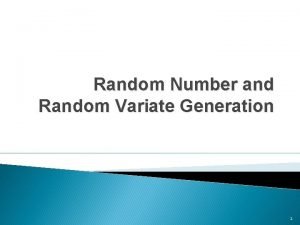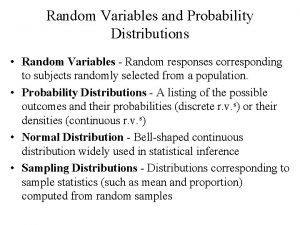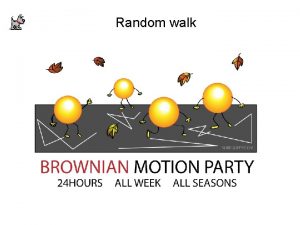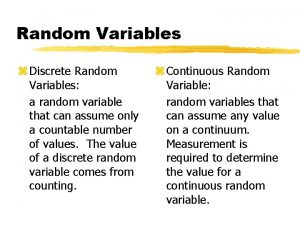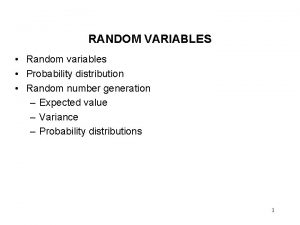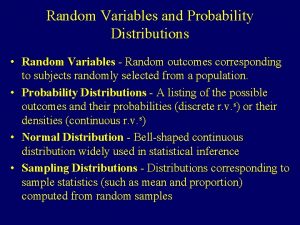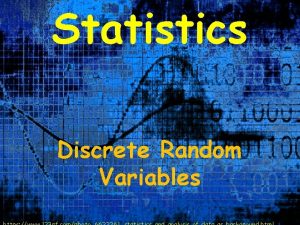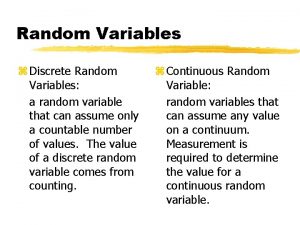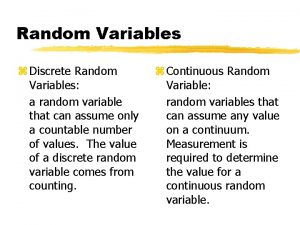3 2 Scaled Random Walks 3 2 Scaled


























- Slides: 26

3. 2 Scaled Random Walks 黃于珊

3. 2 Scaled Random Walks • Properties of symmetric random walk • Increments • Martingale • Quadratic Variation

3. 2. 1 Symmetric Random Walk Toss a fair coin repeatedly • With each toss, it either steps up one unit or down one unit, and each of the two probabilities is equally likely • Define =0, is a symmetric random walk 3

3. 2. 2 Increments of the Symmetric Random Walk • A random walk has independent increments • If we choose nonnegative integers 0= , are independent

3. 2. 2 Increments of the Symmetric Random Walk is called an increment of the random walk • ki+1=4 k 1 k 2 3= ki ki+1 =5 • Increments over nonoverlapping time intervals are indep. because they depend on different coin tosses • E( )=0 • Var( )= M 5 -M 3=X 4+X 5

Proof of

Proof of =ki+1 -(ki+1)+1

3. 2. 3 Martingale Property for the Symmetric Random Walk • Choose nonnegative integers k < l , then, Linearity of conditional expectations Mk為Fk可測 • 在Fk資訊集合的情況下Ml的期望值為Mk 8

3. 2. 4 Quadratic Variation of the Symmetric Random Walk • The quadratic variation up to time k is defined to be (3. 2. 6) One-step increments Mj-Mj-1=Xj, Xj 2=1 • Note : .This is computed path-by-path .by taking all the one-step increments along that path, squaring these increments, and then summing them 9

How to compute the 10

3. 2. 5 Scaled Symmetric Random Walk • (3. 2. 7) integer s t u 11


Property of Scaled Random Walk because they depend on different coin tosses


The martingale property for scaled random walk ØLet be given, and decompose as ØIf s and t are chosen so that ns and nt are integers 15

Prove W(n) (t) is mtgle. Linearity of conditional expectations 16

Quadratic variation of the scaled random walk 每段時間的增量 平方後加總 Mj-Mj-1=Xj , Xj 2=1 進行計算的 時間長度 17

3. 2. 6 Limiting Distribution of the Scaled Random Walk • fixed a sequence of coin tosses and drawn the path of the resulting process as time t varies Figure 3. 2. 2 • Fix t and consider the set of all possible paths evaluated at that time t ØSet t = 0. 25 and consider the set of possible values of ØM 25 can take any odd integer (丟奇數次 奇H, 偶T 偶H, 奇T ) between -25 and 25 W(100)(0. 25) can take any of the values -2. 5, -2. 3, …, -0. 3, -0. 1, 0. 3, … 2. 3, 2. 5 ØIn order for to take value 0. 1, we must get 13 H and 12 T in the 25 coin tosses. The probability of this is 18

the distribution of is nearly normal E(W(n)(t)- W(n)(s))=0 Var(W(n)(t)- W(n)(s))=t-s S=0 E(W(n)(t))=0 Var(W(n)(t))=t N(0, 0. 25) 0. 2 The bar has width 0. 2, its height must be 0. 1555 / 0. 2 = 0. 7775 19

Approximate the integral • Given a continuous bounded function g(x) • Asked to compute • We can obtain a good approximation by multiplying g(x) by the normal density and integrating (3. 2. 12) • The Central Limit Theorem asserts that the approximation in (3. 2. 12) is valid 20

Theorem 3. 2. 1 (Central Limit Theorem) • Outline of proof: 藉由動差生成函數(MGF)的唯一性來判斷r. v. 屬於何種分配 as as 21

X~N(0, t) Normal density N(ut, t) =1



-ux

W(100)(0. 25)~N(0, 0. 25)
 She who walks with integrity walks securely meaning
She who walks with integrity walks securely meaning Random walks
Random walks Scaled random walk
Scaled random walk Random assignment vs random selection
Random assignment vs random selection Random assignment vs random sampling
Random assignment vs random sampling How creatures move poem
How creatures move poem Once upon a time there lived a little
Once upon a time there lived a little She walks in beauty message
She walks in beauty message Quinton typically walks 28 yards south
Quinton typically walks 28 yards south Walks talent management
Walks talent management She walks in beauty metaphors
She walks in beauty metaphors Quantum walks
Quantum walks Steve walks from point p to point q
Steve walks from point p to point q Theme of the poem she walks in beauty
Theme of the poem she walks in beauty He who walks with the wise grows wise
He who walks with the wise grows wise What does purest heart mean
What does purest heart mean A woman walks into a hospital clutching her abdomen
A woman walks into a hospital clutching her abdomen Past simple with wh questions
Past simple with wh questions What can run but never walks has a mouth
What can run but never walks has a mouth Gordon 101 poems
Gordon 101 poems Walks in inverurie
Walks in inverurie Lord byron
Lord byron Jazz square steps
Jazz square steps Manisha has secured 79
Manisha has secured 79 She walks in beauty annotations
She walks in beauty annotations Fire and ice (poem) book buy
Fire and ice (poem) book buy She walks in beauty theme
She walks in beauty theme


